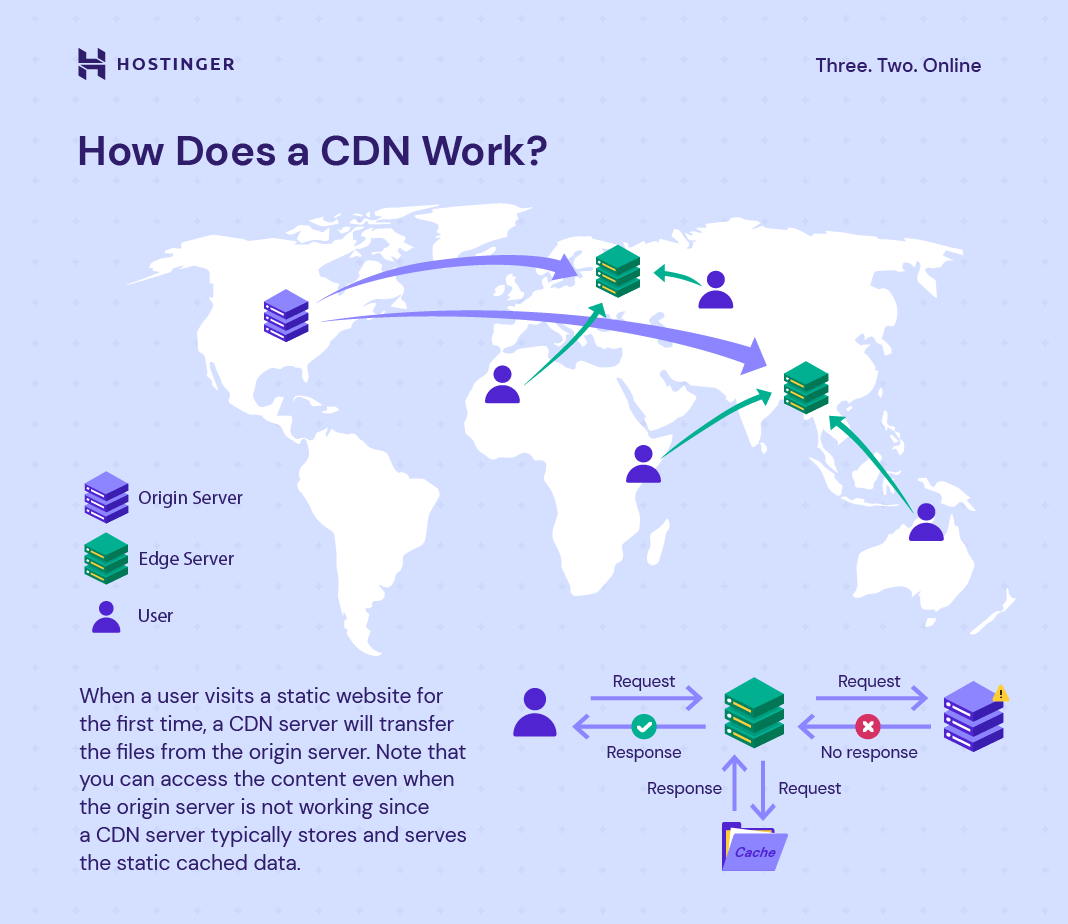The Synergy of Cloudflare and CDN Technologies

Introduction:
Cloudflare and Content Delivery Networks (CDNs) play a vital role in the modern internet landscape, providing essential services to websites and online businesses. Their combined capabilities can optimize website performance, enhance security, and improve user experience.
Cloudflare: A Comprehensive Solution:
Cloudflare is a comprehensive platform that offers a range of services, including:
- Web Application Firewall (WAF): Protects websites from malicious attacks such as SQL injections and cross-site scripting (XSS).
- Content Delivery Network (CDN): Caches static content (e.g., images, JavaScript, CSS) on edge servers for faster delivery.
- Domain Name System (DNS) Management: Provides reliable and fast DNS resolution for websites.
- Bot Management: Identifies and blocks malicious bots, preventing them from scraping and crawling websites.
CDNs: Enhancing Content Delivery:
Content Delivery Networks (CDNs) serve static content from servers located near users, resulting in reduced latency and improved website loading speeds. Key features include:
- Edge Servers: Deploy content on servers strategically distributed across the globe, bringing it closer to users.
- Optimized Routing: Directs user requests to the nearest edge server for efficient content delivery.
- Caching: Stores frequently accessed content locally, reducing the load on origin servers and accelerating delivery.
- Load Balancing: Distributes traffic across multiple servers, ensuring availability and preventing bottlenecks.
Synergy of Cloudflare and CDNs:
Combining Cloudflare and CDNs amplifies their capabilities, offering a comprehensive solution for website optimization and security:
- Enhanced Performance: Cloudflare’s CDN caches static content and optimizes routing, while CDNs provide dedicated servers for faster delivery.
- Improved Scalability: The combined capacity of Cloudflare and CDNs allows for handling high traffic volumes and peak usage.
- Increased Security: Cloudflare’s WAF and bot management protect against attacks, while CDNs prevent content tampering and unauthorized access.
- Cost Optimization: CDNs reduce bandwidth consumption and server load, leading to reduced hosting and infrastructure costs.
Conclusion:
The synergy of Cloudflare and CDN technologies provides website owners with a powerful solution to enhance performance, ensure security, and improve user experience. By combining Cloudflare’s comprehensive services with the specialized content delivery capabilities of CDNs, businesses can optimize their online presence and stay competitive in today’s digital environment.## The Synergy Of Cloudflare And CDN Technologies
Introduction:

In the modern digital landscape, website performance and security are paramount for businesses to succeed. Content Delivery Networks (CDNs) and Cloudflare are two indispensable technologies that synergistically enhance website performance, security, and reliability. This article delves into the captivating world of Cloudflare and CDN technologies, exploring their benefits, functionalities, and the seamless integration between them. Dive in to unlock the transformative power of this dynamic duo.

Executive Summary:
Cloudflare, a global cloud platform, and CDNs offer a comprehensive suite of website performance and security solutions. Together, they optimize content delivery, mitigate security threats, and enhance the overall user experience. This synergistic combination empowers businesses to maximize website uptime, reduce latency, and build a robust digital presence.
Cloudflare
Cloudflare is a cloud-based platform that provides a range of services to enhance website security, performance, and reliability. Its global network of servers strategically placed in over 200 locations worldwide offers the following key benefits:
- CDN Integration: Cloudflare seamlessly integrates with CDNs, enabling the caching of static content on edge servers closer to users. This reduces latency and improves page load speeds.
- DDoS Mitigation: Cloudflare’s powerful DDoS mitigation capabilities protect websites from malicious attacks by filtering out malicious traffic at the network edge.
- Web Application Firewall (WAF): Cloudflare’s WAF safeguards websites from common vulnerabilities and exploits, such as SQL injection and cross-site scripting (XSS) attacks.
- SSL/TLS Certificates: Cloudflare provides SSL/TLS certificates to encrypt website traffic and protect sensitive data, enhancing website security and trust.
CDN Technologies
Content Delivery Networks (CDNs) are distributed networks of servers deployed in multiple geographic locations. They cache static website content, such as images, videos, and scripts, on these edge servers, offering the following advantages:
- Reduced Latency: CDNs reduce latency by delivering content from servers closest to users, resulting in faster page load times and improved user experience.
- Enhanced Scalability: CDNs provide scalability by distributing website content across a large network of servers, handling high traffic volumes without performance degradation.
- Improved Reliability: CDNs increase website reliability by providing multiple redundant servers. If one server experiences an outage, content can still be delivered from other servers, ensuring uninterrupted service.
- Reduced Bandwidth Costs: By caching content locally, CDNs reduce the bandwidth required to deliver content to users, potentially lowering bandwidth costs.
Benefits of Cloudflare and CDN Integration
The integration of Cloudflare and CDN technologies synergistically amplifies website performance, security, and reliability. Key benefits include:
- Optimized Content Delivery: Cloudflare seamlessly integrates with CDNs to cache static content on edge servers, reducing latency and improving page load speeds.
- Enhanced Security: Cloudflare’s DDoS mitigation capabilities, WAF, and SSL/TLS certificates, coupled with CDN’s global distribution, offer robust protection against security threats.
- Improved User Experience: Faster page load times, reduced latency, and enhanced security contribute to an improved overall user experience, increasing user engagement and satisfaction.
- Increased Website Reliability: CDN’s multiple redundant servers and Cloudflare’s global network ensure high website uptime and reliability, reducing downtime and lost revenue.
- Cost Optimization: By reducing bandwidth usage and providing DDoS mitigation services, the combination of Cloudflare and CDNs can potentially lower website costs.
FAQs
-
How does Cloudflare work with CDN technologies?
- Cloudflare integrates with CDNs by caching static content on CDN edge servers, enabling faster content delivery and mitigating security threats.
-
Can I use Cloudflare without a CDN?
- Yes, Cloudflare offers a range of security and performance services that can be used without a CDN. However, integrating with a CDN further enhances website performance.
-
How much does it cost to use Cloudflare and a CDN?
- Cloudflare offers various pricing plans based on service tiers. CDN costs vary depending on the provider, bandwidth usage, and additional features required.
Conclusion
Cloudflare and CDN technologies are a dynamic duo that transforms website performance, security, and reliability. Their synergistic integration unlocks a realm of benefits, including optimized content delivery, enhanced security, improved user experience, increased website reliability, and potential cost optimization. By embracing this potent combination, businesses can establish a robust digital presence, maximize website uptime, and soar above the competition.
Keywords:
- Cloudflare
- CDN
- Content Delivery Networks
- Website performance
- Website security
